Related Research Articles
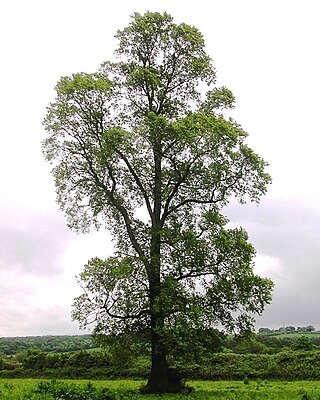
Elms are deciduous and semi-deciduous trees comprising the genus Ulmus in the family Ulmaceae. They are distributed over most of the Northern Hemisphere, inhabiting the temperate and tropical-montane regions of North America and Eurasia, presently ranging southward in the Middle East to Lebanon and Israel, and across the Equator in the Far East into Indonesia.
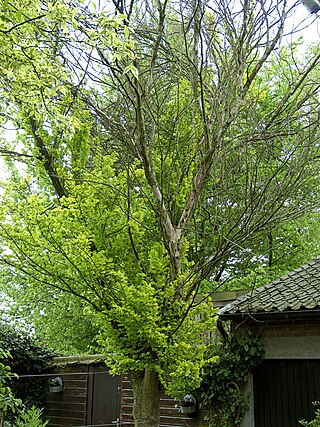
Dutch elm disease (DED) is caused by a member of the sac fungi (Ascomycota) affecting elm trees, and is spread by elm bark beetles. Believed to be originally native to Asia, the disease was accidentally introduced into America, Europe, and New Zealand. In these regions it has devastated native populations of elms that did not have resistance to the disease. The name "Dutch elm disease" refers to its identification in 1921 and later in the Netherlands by Dutch phytopathologists Bea Schwarz and Christine Buisman, who both worked with professor Johanna Westerdijk. The disease affects species in the genera Ulmus and Zelkova, therefore it is not specific to the Dutch elm hybrid.

Ulmus glabraHudson, the wych elm or Scots elm, has the widest range of the European elm species, from Ireland eastwards to the Ural Mountains, and from the Arctic Circle south to the mountains of the Peloponnese and Sicily, where the species reaches its southern limit in Europe; it is also found in Iran. A large deciduous tree, it is essentially a montane species, growing at elevations up to 1,500 m (4,900 ft), preferring sites with moist soils and high humidity. The tree can form pure forests in Scandinavia and occurs as far north as latitude 67°N at Beiarn in Norway. It has been successfully introduced as far north as Tromsø and Alta in northern Norway (70°N). It has also been successfully introduced to Narsarsuaq, near the southern tip of Greenland (61°N).

Ulmus minor subsp. minor, the narrow-leaved elm, was the name used by R. H. Richens (1983) for English field elms that were not English elm, Cornish elm, Lock elm or Guernsey elm. Many publications, however, continue to use plain Ulmus minor for Richens's subspecies, a name Richens reserved for the undifferentiated continental field elms. Dr Max Coleman of Royal Botanic Garden Edinburgh argued in his 2002 paper 'British Elms' that there was no clear distinction between species and subspecies.

Ulmus 'San Zanobi' is a hybrid elm cultivar raised by the Istituto per la Protezione delle Piante (IPP) in Florence, from a crossing of the Dutch hybrid 'Plantyn' and the Siberian Elm Ulmus pumila clone 'S 15'; it was released to commerce in 2002. 'San Zanobi' was introduced to the UK in 2004 by Hampshire & Isle of Wight Branch, Butterfly Conservation, as part of its assessment of DED-resistant cultivars as potential hosts of the endangered White-letter Hairstreak.

Ulmus 'Plinio' is a hybrid elm cultivar derived from a crossing of the Dutch cultivar 'Plantyn' with the Siberian Elm Ulmus pumila clone 'S.2'. 'Plinio' was raised by the Istituto per la Protezione delle Piante (IPP), in Florence and released for sale in 2003. 'Plinio' was introduced to the UK in 2004 by Hampshire & Isle of Wight Branch, Butterfly Conservation, as part of its assessment of DED-resistant cultivars as potential hosts of the endangered White-letter Hairstreak.

Ulmus davidiana var. japonica, the Japanese elm, is one of the larger and more graceful Asiatic elms, endemic to much of continental northeast Asia and Japan, where it grows in swamp forest on young alluvial soils, although much of this habitat has now been lost to intensive rice cultivation.
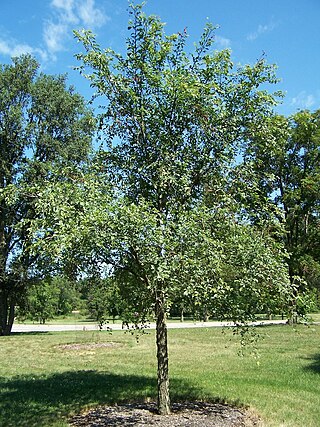
Ulmus chenmouiW. C. Cheng, commonly known as the Chenmou, or Langya Mountain elm, is a small deciduous tree from the more temperate provinces of Anhui and Jiangsu in eastern China, where it is found at elevations below 200 m on the Langya Shan and Baohua Shan mountains. The tree was unknown in the West until 1979, when seeds were sent from Beijing to the De Dorschkamp research institute at Wageningen in the Netherlands.

Ulmus szechuanicaFang, known as the Szechuan (Sichuan), or red-fruited, elm, is a small to medium deciduous Chinese tree found along the Yangtze river through the provinces of Sichuan, Jiangxi, Anhui, and Jiangsu.

Ulmus 'Lobel' is a Dutch hybrid cultivar raised at the Dorschkamp Research Institute for Forestry & Landscape Planning, Wageningen, from a crossing of clone '202' with '336'. 'Lobel' was cloned in 1962 and released for sale in 1973.
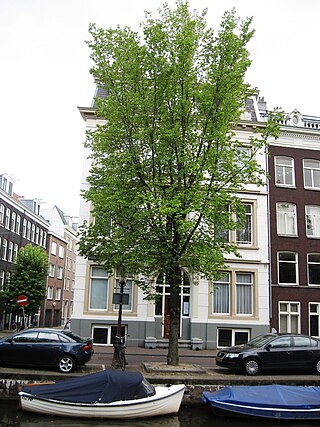
Ulmus 'Plantyn' was one of three Dutch hybrid elms released by the Dorschkamp Research Institute for Forestry & Landscape Planning, Wageningen, in 1973. Derived from a crossing of the Dutch hybrids '202' and '302', it was to prove of great significance in later developments. A selfed seedling was to become the first Dutch clone to prove effectively immune to disease, released in 1989 as 'Columella'. 'Plantyn' was also destined to be the female parent of Lutèce released in 2002. In Italy, 'Plantyn' was used again as female parent in hybridizations with the Siberian Elm Ulmus pumila by the Istituto per la Protezione delle Piante (IPP), to create three new cultivars better adapted to the Mediterranean climate.

Ulmus 'Columella' is a Dutch elm cultivar raised by the Dorschkamp Research Institute for Forestry & Landscape Planning, Wageningen. Originally thought to have been derived from a selfed or openly pollinated seedling of the hybrid clone 'Plantyn', DNA analysis later determined it arose from a cross of 'Plantyn' and Ulmus minor. Sown in 1967, it was released for sale in 1989 after proving extremely resistant to Dutch elm disease following injection with unnaturally high doses of the pathogen, Ophiostoma novo-ulmi. However, propagated by grafting onto wych elm rootstocks, graft failure owing to incompatibility has become a common occurrence in the Netherlands.

Ulmus 'Exoniensis', the Exeter elm, was discovered near Exeter, England, in 1826, and propagated by the Ford & Please nursery in that city. Traditionally believed to be a cultivar of the Wych Elm U. glabra, its fastigiate shape when young, upward-curving tracery, small samarae and leaves, late leaf-flush and late leaf-fall, taken with its south-west England provenance, suggest a link with the Cornish Elm, which shares these characteristics. The seed, however, is on the stalk side of the samara, a feature of wych elm and its cultivars, whereas in hybrids it would be displaced towards the notch.

The Japanese Elm cultivar Ulmus davidianavar.japonica 'Jacan' is a cold-resistant selection from Canada. The tree was one of a group of second-generation japonica seedlings raised in the 1970s, originally for use in the prairie regions, by the Morden Research Station, Morden, Manitoba. It was first distributed in 1977, and was later among the Asiatic elms, some sourced from Canada, donated to the UK in 1980 by the London branch of Mitsui & Co.

Ulmus 'Patriot' is a hybrid cultivar raised by the United States National Arboretum in 1980. Derived from a crossing of the American hybrid 'Urban' with the Wilson's Elm cultivar 'Prospector', 'Patriot' was released to commerce, free of patent restrictions, in 1993. Tested in the US National Elm Trial coordinated by Colorado State University, 'Patriot' averaged a survival rate of 85% after 10 years.
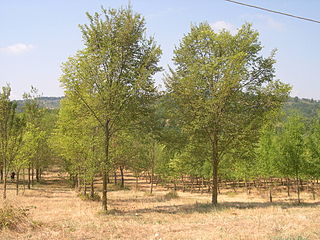
Ulmus 'Arno' is an Italian hybrid cultivar derived from a crossing of 'Plantyn' with the Siberian Elm Ulmus pumila clone S.2. It was raised by the Istituto per la Protezione delle Piante (IPP) in Florence, and released in 2007. However, 'Arno' was not a commercial success; propagation had ceased by 2010, and it is no longer patent protected.

Ulmus 'Fiorente' is a hybrid cultivar elm derived from a crossing of the Siberian Elm Ulmus pumila clone 'S.10' from Lucca, Italy, with the Ulmus minor clone 'C.02' from Lungarno, Florence, by the Istituto per la Protezione delle Piante (IPP), part of the Italian National Research Council, in Florence. The tree is protected by Plant Breeders' Rights bestowed by the EU on 25 March 2010.

Ulmus 'Morfeo' is a hybrid elm cultivar raised by the Istituto per la Protezione delle Piante (IPP), Florence, in 2000. 'Morfeo' arose from a crossing of the Dutch hybrid clone '405' and the Chenmou Elm, the latter a small tree from the provinces of Anhui and Jiangsu in eastern China, The '405' clone is a full sister of 'Groeneveld', a crossing of an English U. × hollandica and a French U. minor from the Barbier Nursery, Orléans.

Ulmus 'Wingham' is a complex hybrid elm cultivar featuring two Asiatic and two European species, bestowing it with an exceptionally high resistance to Dutch elm disease (DED). It was raised as clone no. FL493 by the Istituto per la Protezione delle Piante (IPP) in Florence, but never patented owing to its limited aesthetic appeal. It was introduced to the UK in 2011 by David Herling, Resistant Elms, who trialled it successfully at Wingham in Kent. It was later trialled by Hampshire & Isle of Wight Branch, Butterfly Conservation, as part of an assessment of DED-resistant cultivars as potential hosts of the endangered White-letter Hairstreak. 'Wingham' was released for sale in the UK in 2019.
References
- ↑ Santini A., Fagnani A., Ferrini F. & Mittempergher L., (2002) San Zanobi and Plinio elm trees. [ permanent dead link ]HortScience 37(7): 1139-1141. 2002. American Society for Horticultural Science, Alexandria, VA 22314, USA.
- ↑ Santini A., Fagnani A., Ferrini F., Mittempergher L., Brunetti M., Crivellaro A., Macchioni N. (2004). Elm breeding for DED resistance, the Italian clones and their wood properties. Archived 2007-10-26 at the Wayback Machine Invest Agrar: Sist. Recur. For. (2004) 13 (1), 179-184. 2004.
- ↑ Santini, A., Pecori, F., Pepori, A., & Brookes, A. (2011). 'Morfeo' Elm: a new variety resistant to Dutch elm disease. Forest Pathology, April 2012, Vol. 42, Issue 2, 171-176